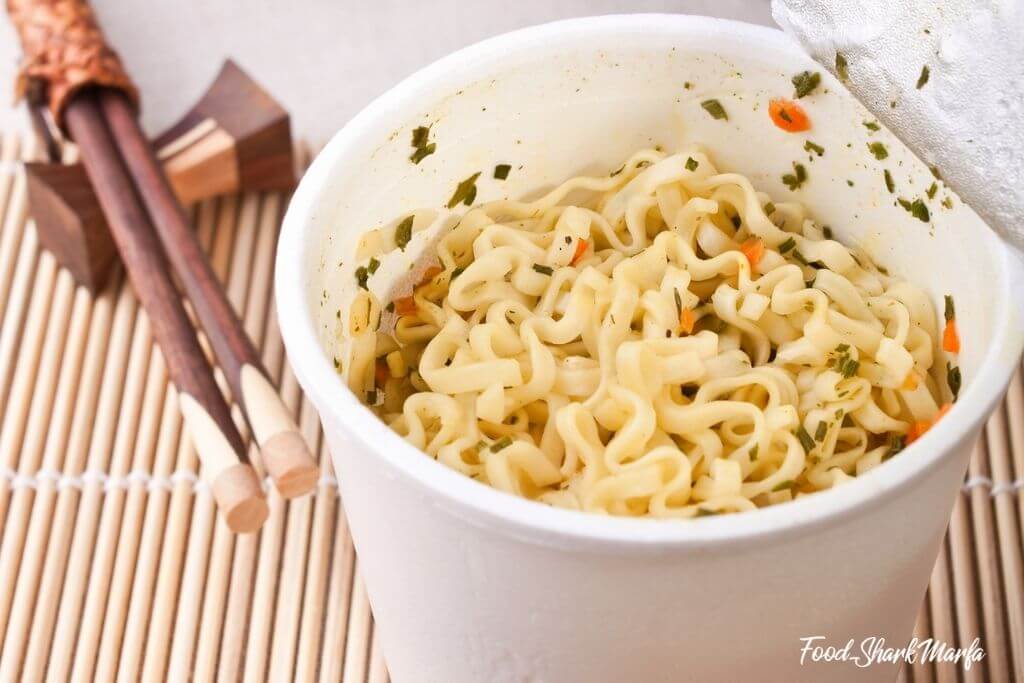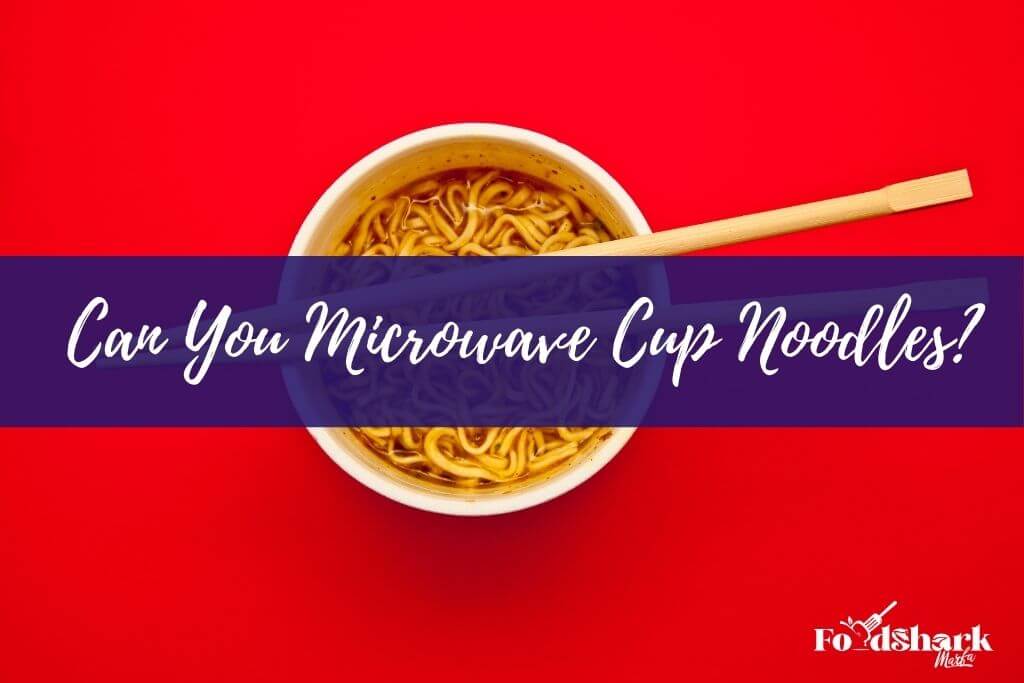As a fast and easy meal, many of us can and will confess to having enjoyed cup noodles now and then. Traditionally made by adding boiling water from the kettle to the cup and leaving to stand for a few minutes if you only have access to a microwave rather than a kettle – such as in the office - it can be tempting to prepare cup noodles in the microwave.

Can you microwave cup noodles though? The answer is no, you cannot and should not microwave cup noodles in the cup unless the cup noodles say that they are safe to be heated in the microwave. This is because the cup material may be unsafe to be microwaved.
If you do not have access to a kettle or stovetop to boil water up for cup noodles, then read on to find out what ways there are to safely prepare cup noodles.
Why Is It A Problem to Microwave Cup Noodles?
Cup noodles are available packaged in plastic cups, Styrofoam cups and even card cups. There are also instant noodles/ramen which often come in packets rather than cups. Many cup noodle cups say do not microwave or may have a symbol of a microwave with a cross through it to show that it is not microwave safe.
Depending on the type of cup noodles you buy, they may have slightly different preparation instructions but most need you to boil water first and then add the boiling water to the cup noodles before leaving them to stand for a certain amount of time. This is always the fastest and easiest way to prepare cup noodles.

When you microwave cup noodles in the cup, not only can the cup material become damaged in the microwave, but the additional heat can cause the cup (and lid) to leach materials such as bisphenol A into the food. The cup itself can also be damaged increasing the risk of spillage or burns.
Heating in the microwave can also cause the water in the noodles to become overly hot or what is known as superheated . When water is superheated, it has moved past its boiling temperature which increases the risk of scalding or burning your hands or even your mouth when handling and eating the noodles.
Can You Microwave Styrofoam?
When cup noodle containers made from polystyrene or Styrofoam are heated this increases the risk of more chemicals leaching from the Styrofoam into the food. There is also more risk of damaging the container if you try to microwave ramen in Styrofoam cup. So, to answer the above question, no Styrofoam should not be microwaved.
Polystyrene is actually a type of plastic which is made by polymerizing (stringing together) styrene. Polystyrene can also be made into EPS (expanded polystyrene) and XPS (extruded polystyrene) and these are all suitable for food packaging due to their properties. Styrofoam is one of the most well-known forms of XPS and is a trademarked name owned by the Dow Chemical company.

The substance styrene is also found in many other consumer materials such as carpet backing, fiberglass composites and more. Styrene is also found naturally in foods such as beef, coffee, wheat, peaches and strawberries and can be added to some manufactured foods like frozen dairy products.
Styrene and polystyrene are two very different substances. People shouldn’t be confused between styrene, which is the liquid used to make polystyrene and polystyrene itself, which is the type of plastic (American Chemistry Council). Although styrene has been placed on California’s Prop 65 list, it was recognized that ‘in finished products, styrene is not an issue’ and that the safety of polystyrene foodservice packaging was not being questioned.
However, there are concerns over how much styrene we are exposed to on a daily basis and how much may leach into our foods from packaging. Some polystyrene manufacturers also use bisphenol A (BPA) in food packaging, a chemical which remains controversial for its use in food packaging. When food plastics containing BPA are heated, more BPA can leach out of the plastic and into foodstuffs.
BPA can no longer be used in baby products or packaging for baby foods and the FDA continues to review scientific information on BPA to assess whether it will continue to support the safety of BPA in food packaging.
It is worth understanding though that tiny amounts of any type of packaging (such as paper, aluminum or glass) can also leach or migrate into our food. This is the reason why all food packaging is regulated to make sure that the amount of material migrating into the food stays within safe limits.
Any materials that come into contact with food, including polystyrene, are regulated by the FDA. The FDA states that polystyrene is safe for use in contact with food. This is also supported by the European Commission and other regulatory bodies.
How to Microwave Cup Noodles
If you do not have access to a kettle, or stovetop then the you can either boil the water in the microwave or safely microwave cup noodles is by tipping the noodles from the cup, along with the required amount of (cold) water into a good sized microwave food container with a vented lid.
You can add the seasoning at this point or leave it until the noodles are cooked. The noodles should be heated on full power for between three and five minutes or until enough of the liquid has absorbed and the noodles are soft. You may want to check on them and give them a quick stir during the cooking time as this helps break apart any noodles that may be stuck together. It is also important to keep an eye on the noodles while they are heating as there is always a risk of the liquid boiling over.
Once finished, the container can be removed from the microwave using a potholder or towel, give them a stir. If you have not added the seasoning pack then do this now and leave the noodles to stand for at least two minutes or so to allow them to cool before eating.
You can also heat packet noodles in this way, just tip them from the packet into a microwave container and break them apart with your hands before adding cold water and microwaving.
If you have access to the stovetop, you can also boil water in a saucepan and make your cup noodles as instructed on the cup, or heat cup noodles from cold is by tipping the noodles with the required amount of water into the pan and heating on the stovetop.
You can add the seasoning from the start of cooking or just add it at the end once cooked. One your noodles are ready, you can tip them into a bowl or if you are feeling brave, pour or fork them back into the cup so they are ready to eat.

Can You Microwave Maruchan Instant Lunch?
As with other cup noodles, the main reason as to why can’t you microwave Maruchan instant lunch is that preparing them in the microwave can increase the risk of chemicals leaching from the cup into the food. Microwaving can also make the cup itself unstable – increasing the chance of spills or even causing burns.
You can prepare Maruchan instant lunch in any of the ways detailed above for cup noodles though.
Can You Boil Water in A Microwave?
Yes, if you do not have a kettle to hand or a pan and stovetop, then rather than tipping the noodles into a microwave safe container with cold water, you could boil the water for your cup noodles in the microwave.
You will need a microwave safe bowl or jug – a microwave safe jug is better as it’s easier to pour from. Add the required amount of cold water to the jug and heat on high until it is boiling.
Then, turn the microwave off, open the door and leave the water to stand to allow it to cool. Remove the jug from the microwave with an oven mitt or potholder and give the water a gentle stir with a wooden or silicone spoon or spatula as this minimizes risk of scalding from superheated water. You can then carefully pour the hot water onto your cup noodles.
If you want to regularly boil water in a microwave then use the instruction manual to help you calculate the right amount of time needed to heat the water to the correct temperature.
Microwaving a Cup of Noodles in Microwave Without Water
Although cup/ramen noodles are best enjoyed in liquid broth, you can make them dryer. Open the cup or packet of noodles and place them into a microwave safe container with a lid. Add just enough cold water to cover the noodles. Heat on full for no more than two minutes and remove from the microwave. Give the noodles a quick stir at this point, they should be soft. If they are still a bit firm, then return to the microwave for 30 seconds.
Once the noodles are soft, pour away the excess liquid and place the noodles back in the microwave for another 30 seconds. The noodles can then be taken from the microwave, the seasoning added and left to stand for a couple of minutes before eating.
In Conclusion
Unless cup noodles say they can be heated in the microwave, you should not microwave cup noodles. If you have access to a kettle then you are always best boiling water in the kettle and preparing the cup noodles in the way the instructions say.
If you do not have access to a kettle, you can heat the water up first in a saucepan and add it to the noodles in the cup, or tip the cup noodles out into a saucepan, add cold water and heat up the cup noodles from cold in the pan.
You can also tip the noodles into a microwave safe container, add cold water and heat the noodles this way or even just boil the water up in the microwave first and prepare the cup noodles as usual.
If you do use the microwave, always be careful to make sure that you do not superheat the water as this can increase the risk of injury.

